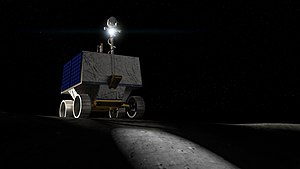 Artist's impression of VIPER operating in darkness. | |
| Names | Volatiles Investigating Polar Exploration Rover |
|---|---|
| Mission type | Exploration, resource prospecting |
| Operator | NASA |
| Website | https://www.nasa.gov/viper |
| Mission duration | 100 days (planned)[1][2][3] |
| Spacecraft properties | |
| Spacecraft type | Robotic lunar rover |
| Manufacturer | NASA Lyndon B. Johnson Space Center |
| Dry mass | 430 kg (950 lb)[4] |
| Dimensions | 2.45 m (8 ft 0 in) in height, 1.53 m (5 ft 0 in) in length and width[5] |
| Start of mission | |
| Launch date | September 2025 (Canceled July 2024) |
| Rocket | Falcon Heavy |
| Launch site | Kennedy Space Center, LC-39A |
| Contractor | SpaceX |
| Moon rover | |
| Landing date | September 2025 (canceled)[6] |
| Landing site | Mons Mouton, South pole region[7][2] |
| Instruments | |
| Neutron Spectrometer System (NSS) Near InfraRed Volatiles Spectrometer System (NIRVSS) The Regolith and Ice Drill for Exploring New Terrain (TRIDENT) Mass Spectrometer Observing Lunar Operations (MSolo) | |
VIPER (Volatiles Investigating Polar Exploration Rover) is a lunar rover which was developed at the NASA Ames Research Center. Before the project was cancelled in 2024 the rover would have been tasked with prospecting for lunar resources in permanently shadowed areas of lunar south pole region, especially by mapping the distribution and concentration of water ice. The mission built on a previous NASA rover concept, the Resource Prospector, which had been cancelled in 2018.[8]
VIPER was to be carried aboard Astrobotic's Griffin lander as part of NASA's Commercial Lunar Payload Services (CLPS) initiative.[9]
- ^ Cite error: The named reference
Crunch Oct2019was invoked but never defined (see the help page). - ^ a b Cite error: The named reference
Loff Oct2019was invoked but never defined (see the help page). - ^ Cite error: The named reference
Bartells Oct2019was invoked but never defined (see the help page). - ^ Colaprete, Anthony (17 August 2020). "VIPER: A lunar water reconnaissance mission" (PDF). NASA. Retrieved 25 August 2020.
 This article incorporates text from this source, which is in the public domain.
This article incorporates text from this source, which is in the public domain.
- ^ "NASA's Next Lunar Rover Progresses Toward 2023 Launch". NASA. 24 February 2021. Retrieved 5 March 2021.
 This article incorporates text from this source, which is in the public domain.
This article incorporates text from this source, which is in the public domain.
- ^ Cite error: The named reference
nasa-20240717was invoked but never defined (see the help page). - ^ Cite error: The named reference
Wright Ladd Colaprete Ladd 2021 s386was invoked but never defined (see the help page). - ^ Bartels, Meghan (16 October 2019). "Moon VIPER: NASA Wants to Send a Water-Sniffing Rover to the Lunar South Pole in 2022". Space.com. Retrieved 13 April 2021.
- ^ "NASA Selects Astrobotic to Fly Water-Hunting Rover to the Moon". NASA. 11 June 2020. Retrieved 14 June 2020.
 This article incorporates text from this source, which is in the public domain.
This article incorporates text from this source, which is in the public domain.